Key takeaways:
- Creating a safe and validating environment is essential for trauma survivors to express their pain and begin their healing journey.
- Mindfulness techniques, such as meditation and focused breathing, can help individuals acknowledge and process their emotions, fostering self-compassion and resilience.
- Practical mindfulness exercises like gratitude journaling, body scanning, and mindful walking can significantly enhance healing and promote connection with one’s body and surroundings.
- Utilizing resources such as mindfulness apps, insightful books, and community workshops can support ongoing mindfulness practice and provide validation through shared experiences.
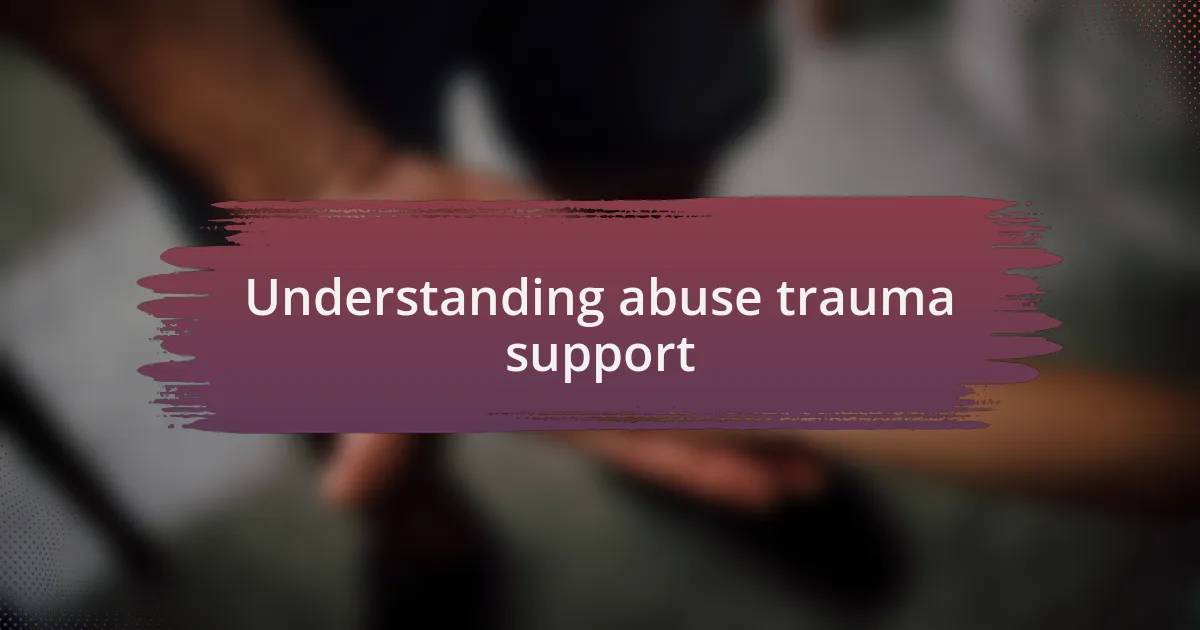
Understanding abuse trauma support
Understanding abuse trauma support is crucial for both survivors and those who want to help them. I recall a time when a friend reached out for support after sharing their story of abuse. It struck me how important it was for them to feel validated and heard, rather than dismissed or judged.
Navigating the landscape of trauma support can often feel overwhelming. What does it truly mean to provide support? For me, it means creating a safe space where individuals can express their pain without fear of repercussions. I find it essential to listen actively, allowing trauma survivors to take the lead in their healing journey.
Moreover, building a network of support is vital. When I explored mindfulness techniques, I discovered that connecting with others who understood my experiences helped me heal. How can we foster these connections in our communities? It begins by recognizing the common thread of shared experiences, empathizing, and providing resources to help others reclaim their voices in the healing process.
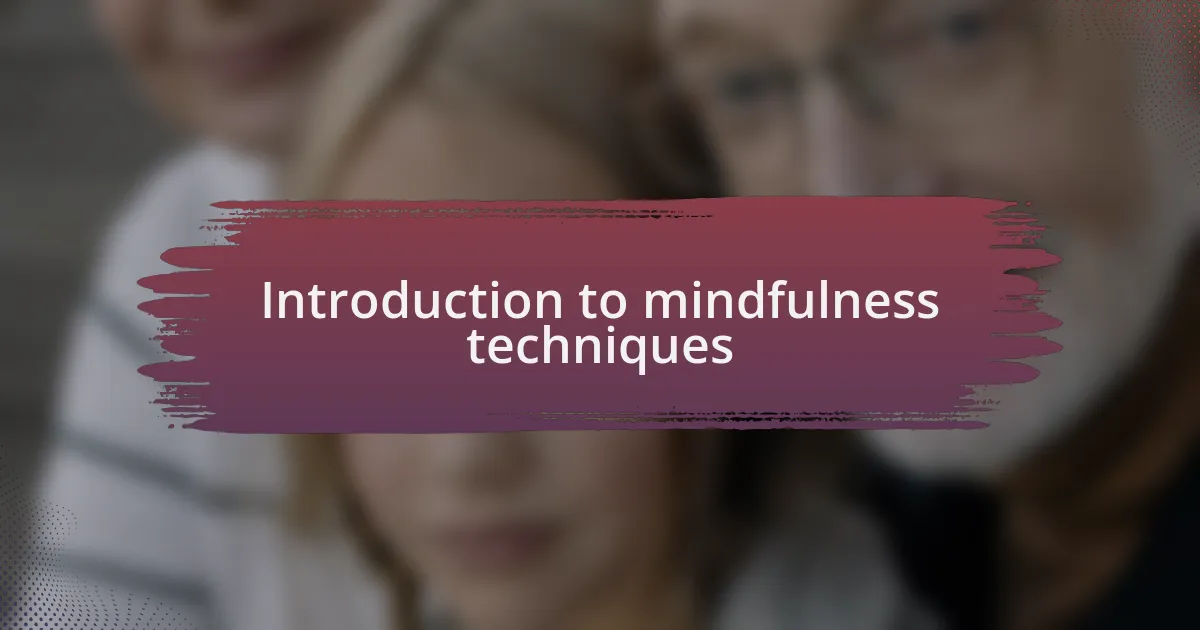
Introduction to mindfulness techniques
Mindfulness techniques offer a powerful tool for those healing from trauma. I remember my first encounter with mindfulness; it felt like stepping into a quiet room after years of chaos. This practice encourages us to immerse ourselves in the present moment, allowing us to observe our thoughts and feelings without judgment. Could something as simple as paying attention to our breath really make a difference? From my experience, it truly can.
At its core, mindfulness is about awareness and acceptance. I found that practicing mindfulness helped me acknowledge my emotions rather than suppressing them, which was particularly challenging after experiencing trauma. By being present, I learned to recognize the triggers that resurfaced my pain, transforming my understanding of these moments. Have you ever noticed how quickly our minds race? Mindfulness teaches us to slow down and truly experience each moment.
Integrating mindfulness into daily life can take many forms—meditation, deep breathing, or simply taking a moment to savor a cup of tea. Each practice serves as a reminder to be gentle with ourselves during tough moments. Personally, I’ve turned to focused breathing exercises in times of distress, and I’ve seen how these seemingly small actions can reshape my response to overwhelming feelings. What small mindfulness practice might you try today to support your journey?
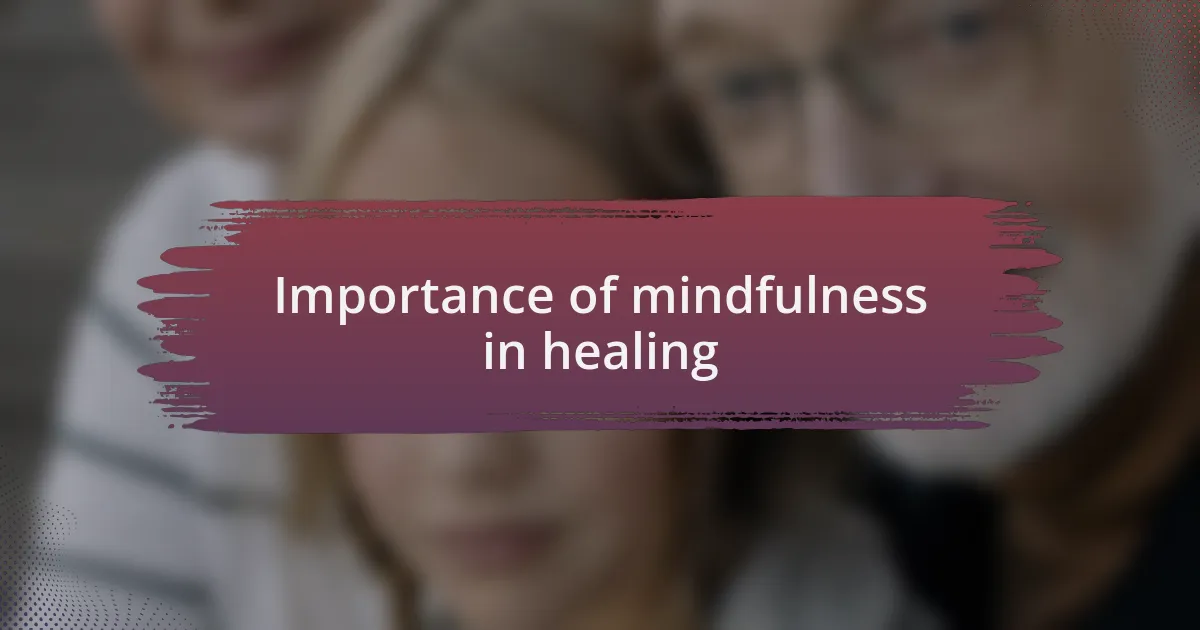
Importance of mindfulness in healing
Mindfulness plays a crucial role in the healing process, especially for those grappling with the effects of trauma. During one particularly overwhelming day, I took a moment to step outside, feeling the sun on my skin and focusing on my breath. It was in that simple act of grounding myself that I realized how essential it is to reconnect with our senses; it helped to quiet the storm of thoughts and emotions swirling within me.
When I reflect on my journey, I can see how mindfulness enabled me to cultivate a sense of safety within myself. By practicing acceptance, I learned to witness my feelings—anger, sadness, fear—without diving into them. I remember the first time I consciously acknowledged a wave of anxiety; it felt strange but powerful. Have you tried observing your emotions instead of reacting to them? This practice offers us a chance for clarity and healing that is often overlooked.
The impact of mindfulness on healing is profound and far-reaching. It provides a pathway to self-compassion, which may often feel unattainable after experiencing abuse. I’ve often found that incorporating just a few minutes of mindfulness each day—whether through meditation or mindful walking—has allowed me to build resilience against triggers and overwhelming memories. What small moments can you embrace today to foster your own healing journey?
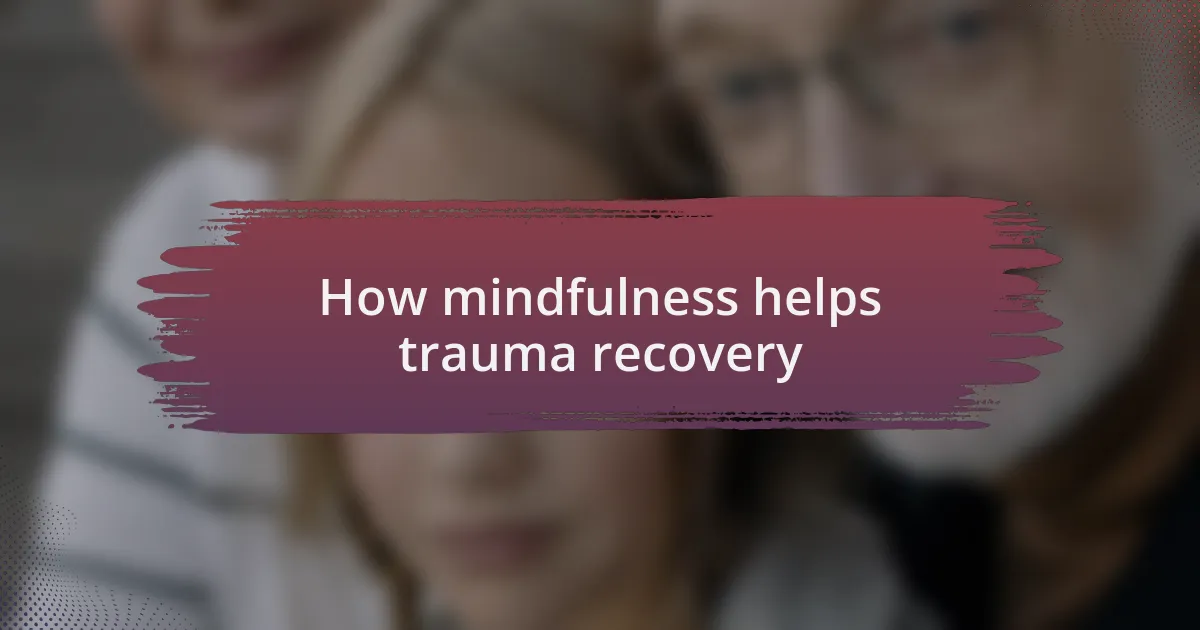
How mindfulness helps trauma recovery
Mindfulness serves as a protective shield in the aftermath of trauma, inviting us to gently engage with our thoughts rather than remain trapped by them. I recall a moment where, during a particularly triggering conversation, I focused on my breath and allowed myself to pause before responding. That single act of mindfulness shifted my perspective and helped me navigate the interaction with a sense of calm I didn’t know I could access.
I’ve experienced firsthand how mindfulness allows me to detach from my trauma narratives. When I practice noticing my surroundings—the sound of the wind, the rustling leaves—I feel a subtle but powerful shift. It’s as if those negative thoughts lose their grip on me. Have you ever noticed how tuning into your environment can quiet the chaos of your mind?
In these moments of mindful awareness, I find a newfound ability to process emotions without becoming overwhelmed. For instance, during a meditation session, I discovered the beauty in simply allowing sadness to be present without judgment. It transformed the way I view my trauma; instead of seeing it as a burden, I began to understand it as a part of my story that I can hold with compassion. How could your perspective shift if you allowed your feelings to exist with kindness?

Practical mindfulness exercises for healing
Practicing gratitude is a powerful mindfulness exercise that has profoundly impacted my healing journey. I remember writing down three things I was grateful for each day, no matter how small they seemed. This simple act shifted my focus from what I had lost to what I still cherish, fostering a sense of hope and resilience. Have you tried keeping a gratitude journal? It might just help you uncover the light amidst the darkness.
Another exercise that has brought me solace is body scanning. Lying quietly, I mentally check in with my body from head to toe, acknowledging areas of tension and discomfort without judgment. This practice helped me reconnect with my body, especially after feeling dissociated during traumatic experiences. Have you ever tried to simply listen to what your body is telling you? Doing so often reveals emotions I wasn’t even aware I was holding onto.
Lastly, engaging in mindful walking has become a sanctuary for me. As I step outside and focus on my breath with each footfall, I notice the world around me—the texture of the pavement, the scent of blooming flowers. This intentional movement helps ground me in the present while allowing feelings of anxiety to dissipate. Can you recall the last time you immersed yourself in nature? It’s a healing balm that reminds us we are part of something bigger, offering solace in our journey.
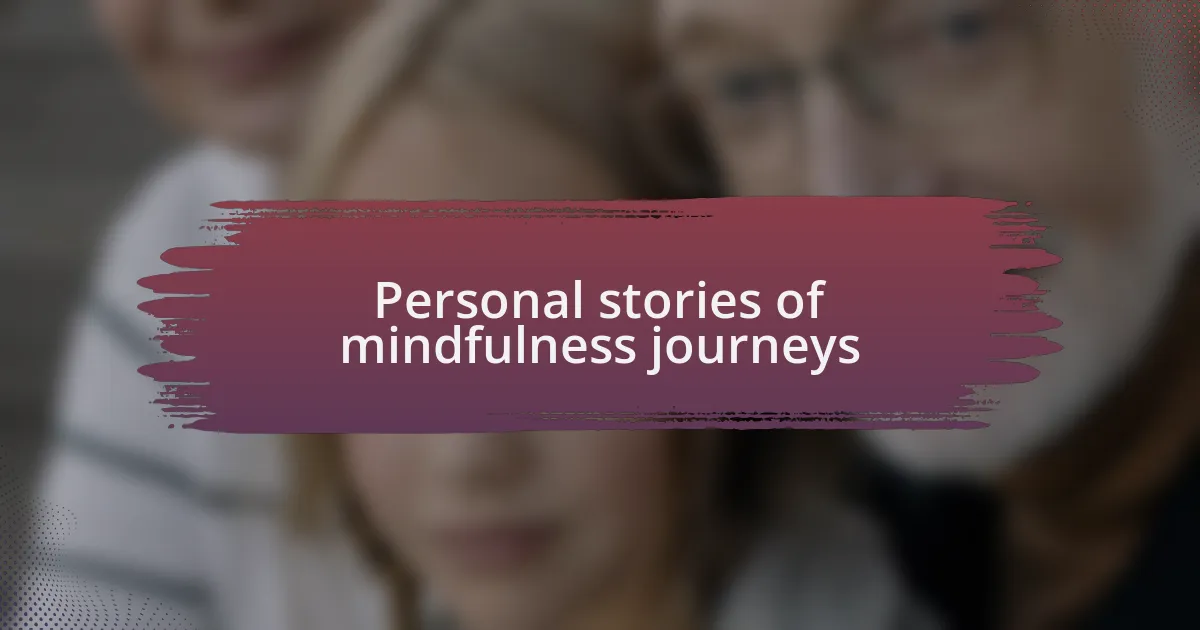
Personal stories of mindfulness journeys
During my exploration of mindfulness, I vividly recall a moment of clarity while practicing loving-kindness meditation. As I silently repeated phrases of well-wishing to myself and others, a wave of warmth spread through me. It was enlightening to realize that I could extend compassion, even to the parts of myself scarred by trauma. Have you ever considered how focusing positive intentions can shift your perspective?
On another occasion, I tried a mindfulness technique known as mindful eating. I savored each bite of my meal, noticing the colors and flavors as if I were experiencing them for the first time. It struck me how often I’ve rushed through meals, detached from the joy of nourishing myself. This experience taught me that pleasure can be found in the simplest of moments. Have you ever stopped to truly savor a meal, instead of just going through the motions?
I’ll never forget the first time I practiced mindfulness through art. Sitting down with a blank canvas, I poured my feelings into vibrant colors without worrying about the outcome. Each stroke became a form of expression, a way to acknowledge my emotions creatively. This experience opened a new avenue for healing, inviting me to embrace imperfection. What creative outlets have you explored in your journey? It’s amazing how art can serve as a refuge, allowing us to navigate our inner landscapes with compassion.
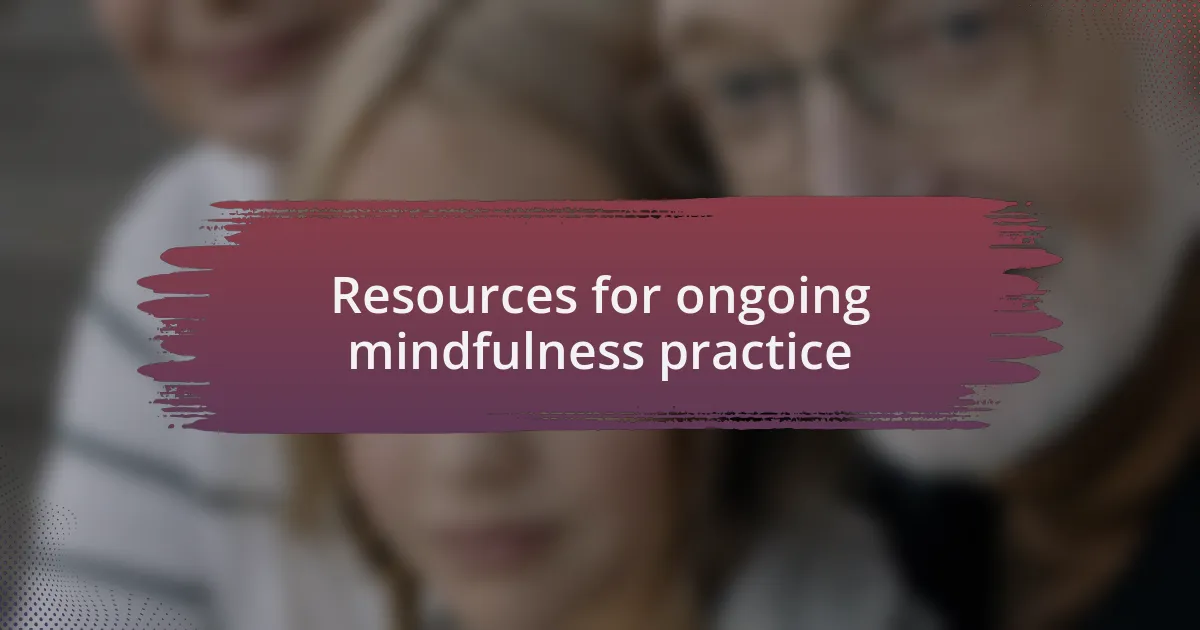
Resources for ongoing mindfulness practice
When it comes to ongoing mindfulness practice, I’ve found numerous resources that resonate deeply with my journey. For instance, I regularly turn to mindfulness apps like Headspace or Calm, which provide guided meditations tailored to those dealing with trauma. Have you ever felt overwhelmed by emotions and didn’t know where to turn? These apps offer a gentle voice to guide you back to a place of peace, making it easier to reconnect with your breath and your body.
Books have also played a pivotal role in my mindfulness journey. One that stands out is “The Miracle of Mindfulness” by Thich Nhat Hanh. It’s filled with practical exercises and personal stories that remind me of the beauty in being present. I often find myself curling up with a cup of tea, reflecting on his insights. Have you considered how a good book can steer your mindfulness practice? Engaging with these texts can provide both inspiration and guidance, enriching your experiences.
I also cherish community resources, such as local mindfulness workshops or support groups. Attending a weekly meditation session not only fosters connection but also deepens my practice. Sharing my experiences with others who understand the weight of trauma has been incredibly validating. Have you thought about joining a group in your area? Finding a supportive community can be a transformative step in making mindfulness a consistent part of your life.